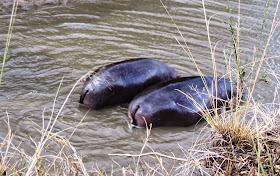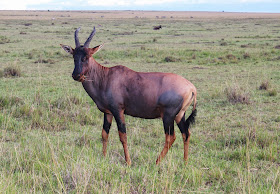ANIMAL SIGHTINGS, MAASAI MARA, DAY 2
Hippos
Crocodiles
Maasai ostrich
Topi
Thomson's gazelles
Maasai ostrich
Topi
Thomson's gazelles
Giraffes
Impala
Jackals
Hyena
*Aardvark
Jackals
(*Only sighting on trip)
We had two days in the Maasai Mara Game Reserve, and our second afternoon drive began with our first hippo sightings. Yeah, they're in there, but you have to look pretty closely. Their disembodied eyes and ears are poking up through the water, somewhat like candles floating in a swimming pool at an outdoor reception. Or maybe more like a double periscope from a huge submarine peering at the enemies on the shore.
More hippos. All told, we saw seven or eight in this location.
One enormous croc lay indifferently inert on the far shore. Judging by the smile on his face, it had been a good day for hunting.

Later in the day we stopped at a different spot on the river with a dual purpose: to see more hippos, and to make a bathroom stop at another luxury squat toilet. I guess the theory is that a patron is supposed to hold on to that red pole for balance, but there was no way I was touching that pole without gloves. Ew and double ew.
Another problem was that between our vehicle and the "bathroom" (I'm not sure what to call it--maybe the literal term "hole in the ground" is the most appropriate) was a long line of siafu, or really large army ants, which our guide told us to be very careful to avoid. They have huge, scissor-like mandibles they use to slice and dice their prey.
This site and several other sites say that the Maasai use the heads of army ants to suture wounds. Supposedly they have the ant bite the wound on both sides, then break off the body. The ant's pincers stay attached, serving as a kind of staple that holds the wound together. On the other end of the life-death spectrum, African kings used to use army ants to execute criminals. A swarm of these covering a human body, something that sounds like it came straight out of an Indiana Jones movie, could do a lot of damage.
The Mara was Hippo Heaven. Our guide noted that hippos kill more humans than any other animal in Africa. Many Africans don't have running water, so they go to the river in the morning to get what they need. Hippos, who leave the river at night to forage, are on their way back to the water at this time. If a human is in a hippo's way, the hippo will crush the human with its powerful jaws, which can open 180°. Think you can run away from this lumbering clod? Nope. Amazingly, hippos can run as fast as 19 mph, much faster than a human, and are very aggressive.

Instead of the top of the head, this time we saw only the backs and rumps. "Hippopotamus" comes from the Greek word for "river horse." Hippos spend most of their time standing in shallow rivers where their feet can reach the bottom. Even mating and birth take place in the water. (I'm not sure what hippo mating looks like, and I never want to know.) Did you know a group of hippopotami is called a "bloat"? Pretty appropriate.
Finally, a few decided to get out of water, putting their decidedly non-svelte bodies on display:
After the elephant and rhino, the hippo is the third largest living land mammal. An adult male can weigh up to 3,300 pounds. Their rotund bodies and stubby legs, along with the incongruous baby pink coloring of their faces and tummies, make them look a lot like pigs, and they smell like pigs too. However, their closest genetic relatives are whales and porpoises.
I love this photo:
That same afternoon we saw a flock of ostriches in the distance. We didn't get very close, and they wouldn't turn around for a group portrait:
Eight scaly crocs waiting for unsuspecting tourists. (My husband always likes to get "just a little closer." It's a good thing we couldn't get to that side of the river.)
Mara rainbow:
An off-duty topi (These are the animals that are often seen standing on mounds and surveying the realm):
Just down the road were a few Thomson's gazelles, just about as easy to recognize as a zebra because of their black racing stripes, their long, slightly curved, striated horns, and the black stripes between their eyes and nose (reminiscent of running mascara):
We had some wonderful giraffe sightings in the Mara, with the elegant, graceful animals allowing our vehicles to get quite close to them. Since it is illegal to feed giraffes or any other animals in the game preserves, they have not developed the habit of sticking their heads into the Land Cruisers looking for treats. They are still very much wild animals that barely tolerate our presence.
Irregularly shaped spots and colored lower legs mark this and all the other giraffes in the Mara as Maasai giraffes:
There are at least seven giraffes in the photo below:

See the hyena strolling through the family gathering? Hyenas have absolutely no manners.

The hyena is the pariah of the savanna, always skulking about, looking for another handout:

Giraffes have an almost eerie sense for parallel lines. Maybe that gift arises from the fact that they are all about length. When we saw groups of them, they were often poised in almost identical stances, like the two on the left or the two on the right below:

Another example:
After a while the group of four giraffes we were watching began to slowly swing their necks back and forth, as if to some lazy waltz tune that only they could hear. It was quite charming:

Then they began to rub each other's necks in what appeared to be romantic flirtation. However, when they started whacking each other with their necks, trying to poke each other with their horns, we realized this was no romance:
The longer we watched, the less friendly, playful, and/or romantic this necking looked:
There are two things to watch for in the video below:
1) the "neck wrestling" of the two giraffes on the left. We learned that this is the giraffe way of establishing dominance. Six-foot-long giraffe necks can weigh up to 500 pounds, and those knobby horns can be a pretty good weapon. They also use their bodies to push against each other in a way that reminded me of Greco-Roman wrestling--very polite, but think of the force of two 2,600 pound bodies going at it like that.
2) the synchronized walking of the two giraffes on the right, starting at about 1:34. We noticed that graceful style again and again when we saw giraffes. They have an uncanny knack for walking with their heads at exactly the same angle as others in their group, and with their steps being perfectly in time. Giraffes would make excellent water ballerinas.
On our first or second day in Africa, our guide Steven had taught us the Swahili word twende, which means "we go." There were some days when he had to ask "Twende?" seven or eight times before we finally replied, "Twende." This was one of those days.
Eventually it was time to return to the lodge for dinner, but we had to take one more good look at the Mara before we left the next morning. The lodge offered a night game drive, complete with a driver, a spotter, night-vision binoculars, and a spotlight. It was a bit pricey, but hey, when would we ever get another chance like this?
Eventually it was time to return to the lodge for dinner, but we had to take one more good look at the Mara before we left the next morning. The lodge offered a night game drive, complete with a driver, a spotter, night-vision binoculars, and a spotlight. It was a bit pricey, but hey, when would we ever get another chance like this?
Unfortunately, pitch black darkness and/or spotlights don't make for very good photography. My best photos were of some impala, identified by their unmistakable lyre-shaped horns:
We saw LOTS of hippos making their way to grassland for their night-time grazing. Our driver told us they go to the same place every night, and at the first sign of dawn, they return to the water. We saw a few family groups of three, but most of them were alone, like this one. Our driver said he was very old and probably looking for his eternal resting place rather than for food:
 |
| Photo by E. Tooke |
 |
| Photo by E. Tooke |
 |
| Photo by E. Tooke |
Next: Crossing the border into Tanzania



























The giraffe necking sessions were one of the highlights of the trip. The other vehicle also saw a leopard not too far from where the giraffes were necking. And of course, the hyena walking through them. So amazing to have so much varied wildlife in such a small area.
ReplyDeleteThat bathroom with description is enough for me to swear of drinking liquids for life.
ReplyDeleteI always thought hippos looked kind of cuddly. Disappointing that they are such killers
Great video of the giraffes. Their parallel behavior almost makes up for the goofy necking stuff.
Hi there, I was just wondering if I could use the aardvark photos in a television show? Thanks,Megan
ReplyDeleteemail me at jkcannon@roadrunner.com
Delete